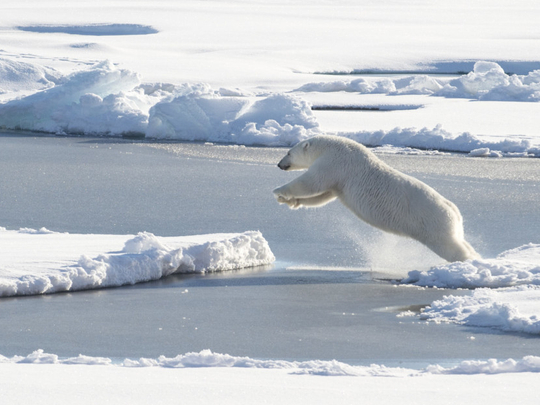
American President Barack Obama should be applauded for gathering world leaders in Anchorage this week for a United States-led conference on ‘Global Leadership in the Arctic’. Yet, the summit’s limited focus on climate change, though undoubtedly important, belies the significance of broader US interests and responsibilities in the Arctic region.
As ice turns to navigable ocean, the Arctic is becoming America’s third great ocean border, creating vexing strategic challenges and unprecedented opportunities. These include not only climate change, but threats to national sovereignty and security, revolutions in international commerce and a ‘Klondike’-like rush to control vast undersea resources.
The US Geological Survey estimates that 13 per cent of the world’s undiscovered oil and 30 per cent of its undiscovered natural gas lie in the Arctic. The US has the potential to be the leader in responsible Arctic oil exploration, as America’s major oil companies maintain the technology and know-how to responsibly tap deep-sea Arctic oil, and could set a new global standard for responsible development and emergency response.
Yet, the US is barely in the game, potentially allowing other nations to move in and develop these resources less safely. The opening of Arctic sea routes will cut transit time between Asian, US and European markets, reducing fuel costs and carbon emissions. A trip via the Northern Route above Russia from Shanghai to Hamburg takes 30 per cent less time than a similar trip through the Suez Canal, while a Northwest Passage trip shaves off days from a trip through the Panama Canal.
However, growing traffic along these routes raises new questions of regulation and sovereignty. President Vladimir Putin of Russia has stated that he wants the Bering Strait to become the next Suez Canal and that any ship passing over large swaths of the Arctic — even the North Pole — may be forced to pay transit fees to Russia. It should not come as a surprise that Russia is investing aggressively in the Arctic: 95 per cent of its gas reserves and 60 per cent of its oil reserves are located in the region. It leads the world with 22 icebreakers and has restored Soviet-era airfields and ports.
China, which is not even an Arctic country, will have built two icebreakers by next year. The US Coast Guard, however, has two functioning icebreakers (the same number as tiny Estonia), and one of these vessels is already a decade past its intended 30-year life span.
The US needs to play catch-up after decades of disengagement. This lack of leadership on a range of Arctic issues — from maritime border disputes to seabed claims — is amplified by the US Senate’s bizarre refusal to ratify the United Nations Convention on the Law of the Sea. More than 165 nations have signed on the convention, which effectively governs territorial and commercial claims on the high seas and has become the primary regime for arbitrating Arctic territorial claims. The US, however, is among the last holdouts refusing ratification, along with North Korea, Iran, Syria and Libya.
This failure to join the convention diminishes US credibility on issues in the Arctic that have tremendous strategic and economic implications. That is why every US president, chairman of the Joint Chiefs-of-Staff, chief of naval operations and Coast Guard commandant since 1994 has called for accession to the treaty. So have the US Chamber of Commerce, as well as countless US oil, shipping, fishing and telecommunications companies that are eager to invest billions in the Arctic, but now must sit on the sidelines without the clear legal rights that the Law of the Sea convention guarantees to other Arctic nations.
In 2012, the last time the treaty was put to a vote, 34 Senate Republicans voted against it, depriving the treaty of the necessary two-thirds majority for ratification. Ratifying the treaty could allow the US to gain new ocean territory twice the size of California, but America does not even have a seat at the negotiating table because a few senators believe the accord would undermine US sovereignty. But this refusal has done far more to undermine US sovereignty and territorial claims than any treaty ever could, as America’s Arctic neighbours assiduously build internationally-recognised claims in the area.
This is all the more striking as the US for long was dominant in the Arctic. Before 1960, it operated a fleet of eight polar icebreakers. In 1957, the first surface ships to navigate the Northwest Passage were Coast Guard cutters and a year later, a Navy submarine became the first to reach the North Pole. The US once invested in more than 600 radar and weather stations, extending from the Aleutian islands to Greenland. And it invested in strategic energy infrastructure such as the Trans-Alaska Pipeline, recognising that responsible Arctic development was central to America’s energy security.
Restoring the US to its historic role as an Arctic power will require a recognition of the complex and strategic issues at stake, long-term investment to improve Arctic infrastructure and capabilities, the adoption of the Law of the Sea convention to have an equal voice in the discussion and a fresh sense of urgency.
— Washington Post
Admiral James Loy, a senior counsellor at the Cohen Group, is a former commandant of the US Coast Guard, administrator of the Transportation Security Administration and deputy secretary of the Department of Homeland Security.









